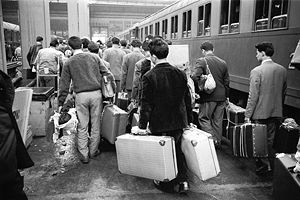
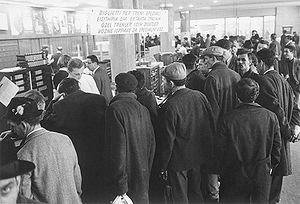
The term "Gastarbeiter" (guest workers; official governmental term: "ausländische Arbeitnehmer” [foreign workers] or "Arbeitnehmer aus den Anwerbeländern” [workers from the recruitment countries]) refers to labour migrants of the so-called first generation who came to the Federal Republic of Germany between 1955 and 1973 under recruitment agreements. They enabled the German economy to compensate for the shortage of labour during the "Wirtschaftswunder" (economic miracle). Partner countries were mainly Italy, Spain, Greece and Turkey. The image of "Gastarbeiter" in Bavaria was mainly shaped by Italians. The proportion of the foreign working population in Bavaria and West Germany rose sharply between 1960 and 1972 (Bavaria: increase from 36,979 to 371,253). At the beginning, unskilled workers were recruited as a priority, with skilled workers following later. A "recruitment freeze" in the Federal Republic of Germany in 1973 ended access for workers from outside the European Economic Community (EEC). Here the Federal Republic of Germany followed a trend that could be observed throughout Western Europe between 1970 and 1974. The success of the "Gastarbeiter" in the German economy led to many of them settling here and their families joining them later. Nevertheless, the vast majority of them returned to their home countries.
Origin and development of the term "Gastarbeiter"
When in 1964 an official welcoming committee in Cologne presented the millionth "Gastarbeiter", Portuguese Armando Rodrigues de Sà (1926–1979), with a Zündapp Mokick as a gift on his arrival in the Federal Republic of Germany, with great media attention, the neologism for the workers recruited abroad since the mid-1950s had long become established in the public debate in West Germany. The relevant official governmental term, however, was "ausländische Arbeitnehmer” (foreign employees) or "Arbeitnehmer aus den Anwerbeländern” (employees from the recruitment countries). The impartial terms "Ausländer” (foreigners) or "Nichtdeutsche” (non-Germans) can be found in official statistics. The application of the term "Gastarbeiter" at local administrative level is first mentioned in the City of Nuremberg‘s 1962/64 administrative report. The word appeared in the press as early as 19 July 1950 in the article "Deutsch-französischer Sozialvertrag" (Franco-German social contract) . The Frankfurter Allgemeine Zeitung (FAZ) evaluated the introduction of this term as an improvement over the biased term "Fremdarbeiter" (foreign workers) in its article "Die ausländischen Arbeitskräfte und Wir. Gastarbeiter – eine neue Bezeichnung für die Fremden" (The Foreign Workers and Us. Gastarbeiter - a new term for the foreigners) on 3 June 1961.
During the NS era, "Fremdarbeiter" were voluntary civilian workers from abroad in the German war economy ("Ausländereinsatz"). For example, Italian agricultural and industrial workers had been recruited for the allied German Reich on the basis of short-term contracts since 1937. The repeatedly modified designations for workers from Fascist Italy in the territory of the Reich reflect the changing relationship between the two dictatorships: "Gastarbeitnehmer" (guest workers), "Arbeitskameraden" (work comrades), "Italienische Militärinternierte" (Italian military internees; for the Italian soldiers used for forced labour in Germany after Italy's change of alliance). The NS regime chose the terms "Arbeitskräfte aus dem Osten" or "Ostarbeiter" (workers from the East) for the Soviet forced labourers. The use of the term "Fremdarbeiter" as a synonym for "Gastarbeiter" was rather the exception in the 1960s (e.g. Nürnberger Nachrichten, 5 June 1964). But even social interest groups and collective bargaining parties still referred to the newcomers from the South as "Fremdarbeiter".
Etymologically, the word "Gastarbeiter" was derived from "Gastarbeitnehmer" (guest employee). Both word creations referred predominantly to Italians. The exchange of "Gastarbeitnehmer" was also mentioned in the intergovernmental "Gastarbeitnehmervereinbarungen" (guest employee agreements) that the Federal Republic of Germany concluded in the early 1950s (1951 with France, 1953 with Italy).
They are to be distinguished from the government agreements on the recruitment and placement of foreign workers that were concluded later. The encyclopaedia “Herders Konversationslexikon” lexicographically recorded "Gastarbeitnehmer" in 1953. In 1954, the German Trade Union Federation (Deutscher Gewerkschaftsbund [DGB]) used the term "ausländische Wanderarbeiter” (foreign migrant workers) – a linguistic alternative from the period of the Wilhelmine Empire and the Weimar Republic for non-domestic workers.
The change of terminology in the post-war period was to distinguish it from the earlier, negatively charged expressions. In popular parlance, the friendly sounding term used for the so-called first generation of labour migrants did not include employed foreigners from neighbouring states, such as Austrians, Dutch and French, who worked in West Germany without the basis of a bilateral agreement, or highly qualified foreign nationals. The common denominator here was the German language or higher social status. The foreigners stigmatised as "Gastarbeiter" were mostly unskilled workers from poor, agricultural regions with no or little knowledge of German. Ethnic affiliation to a country of a usually different cultural area determined the classification.
The euphemistic and contradictory composite "Gastarbeiter" as a term for the workers from the "recruitment countries" during the years of the economic miracle evokes the idea of a temporary solution. It contains the message that "guests" are only those who do not stay permanently and the expectation that they may leave again. While the first word component referred to the concept of a temporary stay of foreign workers, which was to be followed by their return to the respective country of origin (on the so-called rotation principle, see below), the second word component restricted the immigrants to their economic role, namely to perform manual work for the resulting legitimation to live in the host country.
When the inadequacy of the paradoxical slogan came under increasing criticism, the Bundeszentrale für politische Bildung (Federal Agency for Civic Education [bpb]) reacted by publishing the paper "Fremde, Gäste, Freunde – Gastarbeiter in Deutschland" (Foreigners, guests, friends – Guest workers in Germany) in 1966. Teaching materials on the "guest worker problem" followed in the field of compulsory education in 1971. In 1970, the Westdeutscher Rundfunk (WDR) organised a competition to find a more appropriate word for foreign workers. Despite the great response to the initiative, the jury concluded that they had not found a convincing, neutral and unencumbered version for a new expression. The large majority considered "ausländische Arbeitnehmer" (foreign employees) to be the least ambiguous of the terms in use at the time, with "ausländische" and "europäische Mitbürger" (foreign/European fellow citizens) in second and third place. "Besuchstätige” (visiting workers), “Dankarbeiter” (“thanks workers”), “Deutschenhelfer” (“German-helpers”) , “Förderanten” (derived from “fördern”, i. e. “to support”) “Hilfsdeutsche” (“assistant Germans”), “Industrieeuropäer” (“industrial Europeans”), “Konjunkturisten” (derived from “Konjunktur”, i. e. “(economic) boom”), “Leiharbeiter” (temporary workers), “Mitdeutsche” (fellow Germans), “Mietarbeiter” (leased workers), “Auslandsroboter” (“foreign robots”), “Devisenboys” (“foreign currency boys") were other suggested alternatives. Discriminatory language creations such as “Helferos” ("helperos"), "Mulis” (mules) or "Kameltreiber” (camel drivers) indicate the resentment and xenophobia among the German population.
At the beginning of the 1970s, it became apparent that the original concept of employing foreign workers in West Germany for only a short time for purely economic reasons had failed. More and more "Gastarbeiter" were preparing for a longer stay and had family members join them. This situation led to a variety of problems, as the Federal Republic of Germany had not provided for the integration of foreign workers. The term lost its basis to the extent that "Gastarbeiter" became de facto immigrants and disappeared with the first integration measures.
Recruitment, origin, areas of employment
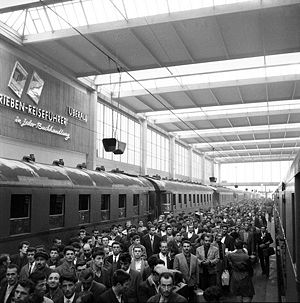
The "Gastarbeiter period" covers the years 1955 to 1973, from the Federal Republic of Germany's first "Recruitment Agreement" to the so-called "recruitment freeze" during the global economic crisis. While the economic upswing in post-war Bavaria, which was dominated by agriculture, began with a certain delay due to above-average unemployment and below-average value creation, a shortage of labour quickly became apparent in agriculture and mining in the Federal Republic's other states. With the emigration of many Germans after the war, the unemployment figures fell as industrial production increased. The government expected a further exhaustion of the domestic labour supply (1.07 million unemployed in 1955) with the planned compulsory military service. In 1954, the DGB spoke out against the officially organised recruitment of foreigners for the Federal Republic's labour market out of consideration for the German employees' "sensitivities". Only later did the trade unions recognise the migrants as their clientele. Only a few workers were placed in West Germany in the first few years. Recruitment only rose steeply when full employment was reached in 1960 (unemployment below one percent), the influx of displaced persons and refugees from Eastern Europe and the GDR as well as internal migration could no longer balance out the demand from booming industry, and finally the construction of the Berlin Wall (1961) put an end to East German immigration – an important recruitment source for new workers.
The "sending countries", which had an interest in the transfer of employee wages for the benefit of their balance of payments, also pushed for the conclusion of "recruitment contracts". In many Mediterranean countries, there was a growing expectation that the pressure on their own labour markets would be relieved by the controlled "export" of unskilled or low-skilled unemployed people. German Minister of Economic Affairs Ludwig Erhard (1897–1977, Federal Minister of Economic Affairs 1949–1963) also feared export restrictions. The first agreement regulating the recruitment and placement of foreign workers was concluded by the federal government in 1955 on the initiative of the traditional emigration country Italy. Corresponding bilateral agreements followed with Spain and Greece (1960), Turkey (1961), Morocco (1963), Portugal (1964), Tunisia (1965) and Yugoslavia (1968).
| State | 6.6.1961 | 30.9.1970 | 30.9.1976 | |||
|---|---|---|---|---|---|---|
| in thousands | in % of all foreigners | in thousands | in % of all foreigners | in thousands | in % of all foreigners | |
| North Rhine-Westphalia | 204,8 | 29,8 | 825,9 | 27,7 | 1.204,8 | 30,5 |
| Baden-Württemberg | 167,5 | 24,4 | 724,3 | 24,3 | 831,9 | 21,1 |
| Bavaria | 110,9 | 16,2 | 497,8 | 16,7 | 641,8 | 16,3 |
| Hesse | 60,7 | 8,8 | 329,7 | 11,1 | 431,3 | 10,9 |
| Federal Territory | 686,2 | 100 | 2976,5 | 100 | 3948,3 | 100 |
Extract from table 27 in: Bethlehem, Heimatvertreibung, 121; foreigners in the federal territory (1964), 646; foreigners in the federal territory on September 30th 1974 (1974), 767, on September 30th 1976 (1976), 724.
Destinations for "Gastarbeiter" in Germany
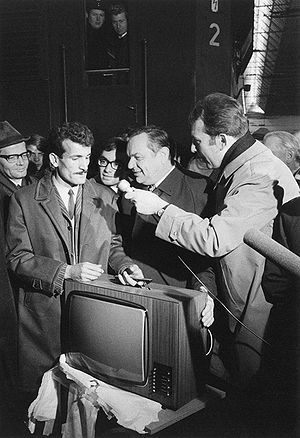
The destinations for "Gastarbeiter" were the West German industrial areas such as Stuttgart (Baden-Württemberg), Cologne (North Rhine-Westphalia), Munich, Wolfsburg (Lower Saxony) and the Ruhr area (North Rhine-Westphalia). The "Weiterleitungsstelle des Landesarbeitsamts Südbayern" (Forwarding Office of the State Labour Office of Southern Bavaria), which was based at Munich Central Station, was responsible for organising the entry of all Southern and South-Eastern European workers into the Federal Republic of Germany and their distribution. The "Gastarbeiter’s" trains arrived here on platform 11. North Rhine-Westphalia had the highest number of foreigners in absolute terms, followed by Baden-Württemberg and Bavaria (table 1). In 1961, half of all foreigners in West Germany were accounted for by the states of North Rhine-Westphalia and Baden-Württemberg alone. Immigration to Bavaria increased when economic growth was well above the average of the other states since the 1970s: in 1970 almost half of all foreigners lived in North Rhine-Westphalia, Baden-Württemberg and Bavaria, and in 1976 more than two-thirds of all foreigners lived there.
| Italy | Greece | Turkey | Yugoslavia | Total | |
|---|---|---|---|---|---|
| 1960 | 93.250 | 9.500 | 102.750 | ||
| 1961 | 107.100 | 21.500 | 2.100 | 130.700 | |
| 1962 | 76.690 | 31.930 | 11.040 | 119.660 | |
| 1963 | 31.830 | 40.600 | 23.430 | 95.860 | |
| 1964 | 26.570 | 40.620 | 54.910 | 122.100 | |
| 1965 | 26.550 | 33.240 | 45.560 | 105.350 | |
| 1966 | 13.405 | 26.876 | 32.538 | 72.819 | |
| 1967 | 3.978 | 1.948 | 7.222 | 13.148 | |
| 1968 | 10.416 | 24.254 | 41.496 | 76.166 | |
| 1969 | 10.215 | 51.253 | 98.172 | 71.690 | 231.310 |
| 1970 | 7.405 | 49.792 | 95.660 | 106.462 | 259.319 |
Bundesanstalt für Arbeit (pub.), Representative Survey 1972, Nuremberg 1973.
Origin of "guest workers"
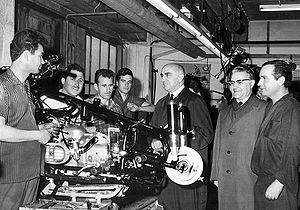
The labour shortage was compensated first and foremost by recruiting Italians, who, unlike the seasonal workers in northern Italy during the period of the Wilhelmine Empire, mainly came from the structurally weak "Mezzogiorno" (in particular Campania, Calabria, Sicily). The largest group among foreign workers until 1970, they had a lasting influence on the image of "Gastarbeiter" and are given greater consideration in this article. In Bavaria, too, Italians were still the largest group of foreigners in 1969, followed by Turks, Yugoslavs, Austrians and Greeks (table 3). Just as in West Germany, the proportion of Italians, Greeks and Spaniards fell, while the proportion of Yugoslavs and, above all, Turks rose as a result of the 1968 and 1961 agreements. The foreign working population grew by leaps and bounds nationwide from 279,390 (1960) to 2.284 million (1972), and in Bavaria from 36,979 (July 1960) to 371,253 (1972).
| 1960 | 1970 | |||||
|---|---|---|---|---|---|---|
| Residential population as of March 31st |
Employed persons as of September 30th |
Residential population as of September 30th |
Employed persons as of June 30th | |||
| Of which male | Of which male | |||||
| Italy | 10.511* | 14.309 | 13.347 | 79.173 | 48.713 | 38.342 |
| Austria | 23.587 | 12.978 | 7.937 | 57.926 | 39.399 | 27.526 |
| Greece | 3.514 | 1.772 | 1.520 | 63.484 | 42.418 | 23.477 |
| Yugoslavia | 7.241 | 899 | 666 | 99.014 | 67.555 | 44.973 |
| Turkey | 1.795 | 307 | 275 | 83.872 | 58.016 | 41.802 |
| Others | 84.254 | 6.714 | 4.982 | 114.308 | 36.776 | 24.169 |
| Total | 130.902 | 36.979 | 28.727 | 497.777 | 292.877 | 200.289 |
Own calculations based on: Statistisches Jahrbuch für Bayern 1961, 27th ed., 18: Ausländer nach ihrer Staatsangehörigkeit (Ergebnis der halbjährigen Ausländererhebung bei den Einwohnermeldeämtern); Statistisches Jahrbuch für Bayern 1972, 30th ed., 26: Ausländer seit 1969 nach der Staatsangehörigkeit (Ergebnisse der Meldungen der Ausländerbehörde), 134: Beschäftigte ausländische Arbeitnehmer nach Staatsangehörigkeit. *: The perceived contradiction between the resident population and the working population can be explained by the different surveys on March 31st and September 30th.
Sectors in which "Gastarbeiter" were employed
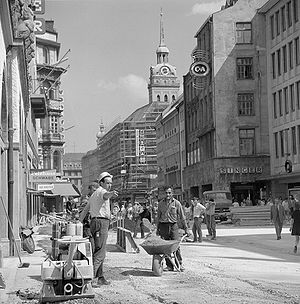
In Bavaria, the Italian migrants worked mainly in building construction and civil engineering – e.g. on the major construction sites in Munich for the the underground and suburban railways and the Olympic Park – and in vehicle construction and mechanical engineering.
Out of a total of 21,522 employed Italians (1961), 19,502 were employed as manual workers, the remainder were salaried employees (942), self-employed (823) and apprentices (231). Italian immigration increased sharply, especially to Munich: between 1960 and 1961 the number of registered Italian citizens rose from 5,319 to 9,789 inhabitants. In 1963, there were already 20,471 Italians of both sexes registered, making up the highest proportion of foreigners in the Bavarian capital at 18.3%. At the end of 1972 there were only 4,677 women among 25,906 officially registered Italians. In September 1961, the statistics for the city and district of Munich recorded 10,075 employees from Italy. Two years later, their share of foreign employees reached 33.6% with 13,332 workers (Munich Labour Office statistics). Among the branches of the economy, building construction and civil engineering (6,613) ranked first, followed by vehicle construction (1,643), mining and quarrying (611), trade and auxiliary trade (563) and catering (451). In 1972, the Italian workforce was mainly distributed among the sectors of building and civil engineering (6,551), trade and auxiliary trade (1,635), catering (1,610), vehicle construction (1,579) and electrical engineering (1,202). The catering sector therefore moved from fifth to third place in terms of employment within nine years, not least due to the boom of tourism since the early 1960s, which made Mediterranean cuisine famous.
Qualifications
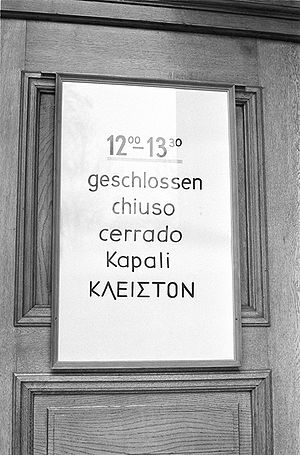
The "Gastarbeiter" often occupied the lowest ranks in the employment hierarchy of the West German host society (rubbish collection, street cleaning). As was already the case in the German Empire, the foreign labour force developed into a social and professional underclass to the German working population, which also benefited the displaced persons and refugees. The "Gastarbeiter" were primarily employed in areas that required them to perform heavy physical labour, combined with piecework and shift work, as well as health risks. At the beginning of the recruitment process (1955), the business community did not demand professionally qualified personnel; the focus was on unskilled or semi-skilled work, mainly in the low segment of industrial production. Only later did field offices of the Bundesanstalt für Arbeit (Federal Labour Office), the so-called Deutsche Kommission (German Commission), which took over recruitment and placement in the respective home countries in consultation with German companies, recruit skilled workers.. Vocational training qualifications were often not recognised because they did not correspond to the German parameters. The Nürnberger Nachrichten wrote in the article "In fremdem Land. Gast ohne echtes Gastrecht" (“In a foreign country. Guest without true right to hospitality”; NN, 16./17.5.1970): "There are few signs indicating that "Gastarbeiter" are regarded as more than relatively cheap labour machines." In this year, the Bundesanstalt für Arbeit recorded less than one percent of all "Gastarbeiter" in its statistics as salaried employees. Significantly, there is therefore no such term as "guest employee".
Rotation and "recruitment freeze"
Recruitment was originally guided by the principle of "rotation", an analytical term for one-year contracts that only appeared in the 1970s. The young and single workers who were in demand because of their mobility – initially there were few female workers – were to stay in the Federal Republic of Germany only for a limited period. The foreign workers did not have any plans to look for a permanent new home either. Their continuing high level of voluntary return migration to their countries of origin seemed to confirm the "rotation principle" as a key element of "Gastarbeit".
However, it was not applied consistently, as trained permanent staff is indispensable for industrial companies. Frequent change was associated with economically expensive training periods for new workers speaking a foreign language. In view of the continuously strong economic growth, employers were interested in longer working stays and in most cases applied for an extension of their approved foreign employee’s work permit, which was almost always granted. When companies, on the recommendation of their foreign employees, requested relatives from the employment office, the chain migration that began as a result led to the gradual emigration of almost entire southern Italian villages to German industrial cities.
Economic buffer
The labour offices were able to flexibly control the duration and scope of employment of foreigners. As long as German industry was not able to recruit enough workers through the domestic labour market, the recruited foreigners were to be used as a mobile labour reserve. This fluctuating labour potential temporarily balanced out seasonal or cyclical bottlenecks on the labour market. In the alternation between upswing and crisis, they took on replacement and expansion or buffer functions on the labour market. The "economic buffer" of foreign employment, already known from the period of the Empire, was already validated during the first recession in 1966/67. Nationwide their employment fell from 1.3 million (1966) to 0.9 million (Jan. 1968). The effects were particularly striking in the construction industry, which is highly dependent on economic cycles. In Bavaria, the recession mainly affected Italian construction workers.
Recruitment freeze
When the energy crisis triggered a stagnation in growth, the German government decided in November 1973 to impose a "recruitment freeze" in the foreign workers' countries of origin in order to relieve the labour market. Due to a gradual informal exchange with countries of parallel industrial development and similar worker recruitment (Switzerland, France) on the consequences of a permanent establishment of these workers with their families, the measure that had been prepared for some time was motivated not only by economic considerations, but also by the administrative recognition of a need for social and legal policy action on how to deal with immigration and new migrants. The recruitment freeze affected workers from countries outside the European Economic Community (EEC).
"Gastarbeiter" were now considered competitors for jobs. The Bundesanstalt für Arbeit ordered that new work permits should only be issued after a strict assessment of the primacy of German nationals. However, despite the requirement not to renew existing employment contracts, in practice the labour offices left the companies with their trained staff.
Right of residence, return, immigration
In fact, the halted influx of foreign workers expedited an unintended development: the measure reinforced the growing tendency of "Gastarbeiter" to shift the centre of their life from their country of origin to the Federal Republic of Germany. As a result, an immigration situation has developed with fluid transitions since the mid-1970s. Since the "recruitment freeze" meant that some of the labour migrants' previous freedoms on the labour market were lost, a voluntary return for a limited period of time to a state outside the EEC, such as Greece, could mean the loss of the acquired residence and labour permit. The "Gastarbeiter population", who did not want to live permanently separated from their families at home, faced the alternative of a permanent return to a future that was often economically and sometimes politically uncertain, or their family joining them in the Federal Republic.
The status under residence law had particularly improved for nationals of member states of the Organisation for European Economic Cooperation (OEEC; from 1961 OECD) and the EEC. As early as 1966, over 90% of Italian workers entered the Federal Republic of Germany by the "second approach" as privileged citizens of the EEC founding state. Among the recruited foreigners, their share dropped to below six percent. The EEC Council Regulation of October 15th 1968 granted workers freedom of movement within the Community. After the "recruitment freeze", the EEC provisions which continued to apply reinforced the legal difference between EEC foreigners and other foreigners.
Since EEC migrants were granted a right of residence, state’s influence and scope for action regarding the course of the migration process was limited. The government had anticipated only a provisionalarrangement, and long-term concepts of a "Gastarbeiter policy" that included the social consequences of longer working stays did not exist in the 1950s or 1960s. Valentin Siebrecht (1957-1972), the director of the Southern Bavarian labour office district, publicly criticised the lack of a concept for the federal government's employment policy for foreigners as early as 1964: "We must plan for the long term, see the problems of foreigners’ work in the larger framework of our social development". Since the majority of migrants returned, as the example of the Italian "Gastarbeiter" shows (table 4), the accusation that the government should have prepared itself much earlier for the permanent integration of foreigners is not justified: of the 14 million or so foreign workers recruited up to 1973, 12 million returned to their home countries with no intention of integration. Nevertheless, it can be noted that it was precisely the termination of recruitment that led to "Gastarbeiter" remaining in Germany so as not to forfeit their right to continue working on the German labour market after a temporary return to their home country.
| Year | Emigrants | Returnees | Returnees per 100 emigrants |
|---|---|---|---|
| 1958 | 10.551 | 6.145 | 58.2 |
| 1959 | 28.394 | 15.295 | 53,9 |
| 1960 | 100.544 | 34.088 | 33,9 |
| 1961 | 114.012 | 48.016 | 42,1 |
| 1962 | 117.427 | 69.600 | 59,3 |
| 1963 | 81.261 | 73.266 | 90,2 |
| 1964 | 75.210 | 58.899 | 78,3 |
| 1965 | 90.853 | 69.485 | 76,5 |
| 1966 | 78.343 | 78.885 | 100,7 |
| 1967 | 47.178 | 56.876 | 120,6 |
| 1968 | 51.152 | 43.402 | 84,8 |
| 1969 | 47.563 | 40.462 | 85,1 |
| 1970 | 42.849 | 36.755 | 85,8 |
| 1971 | 54.141 | 36.241 | 66,9 |
| 1972 | 43.891 | 41.331 | 94,2 |
| 1973 | 41.386 | 37.751 | 91,2 |
| 1974 | 33.485 | 36.809 | 100,6 |
| 1975 | 28.233 | 36.789 | 130,3 |
The figures represent the annual balance (according to ISTAT). It does not include Italians who returned within a year (high proportion). Extract from table 5 in: Rieker, Ein Stück Heimat, 106.
Since the migrant workers had acquired rights under labour and residence lawover time, the state was increasingly losing control over their employment. As early as 1959, the Ninth Ordinance for the Implementation of the Law on Employment Placement and Unemployment Insurance had stipulated that foreign employees acquired a legal entitlement to a work permit without restriction in terms of occupation or business after five years of uninterrupted, dependent and permitted activity in the territory of the Federal Republic of Germany or after eight years of uninterrupted legal residence. After ten years of legal uninterrupted residence in West Germany, a permanent work permit could be issued.
"Gastarbeiter" recruited via the "German Commission" were already in possession of an employment contract before they emigrated and could therefore claim social rights in some cases. Integration problems already arose with the plan to temporarily swap workers in and out as required without having to pay for their education and pensions, and finally with the arrival of children and wives. Since the initial influx was mainly seasonal workers, those responsible for language and social integration measures did not take any precautions.
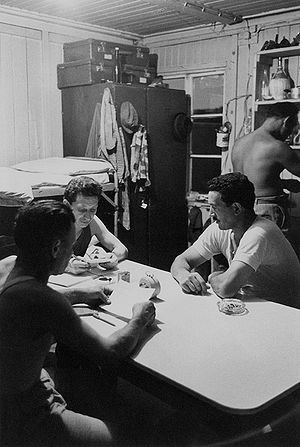
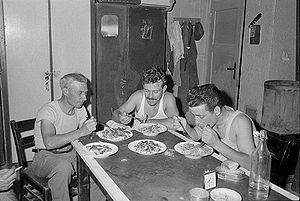
For the time being, the immigrants' life planning also corresponded to the system of "Gastarbeit". For example, the transfer of money to the countries of origin played a central role in the "Gastarbeiter era". In their everyday lives, which were governed by work and abstaining from consumption, many "Gastarbeiter" of both sexes saved up to two thirds of their income to transfer to their home country. The sums involved were sometimes considerable: in 1972, for example, Turkey made up its trade deficit with the Federal Republic of Germany through bank transfers of DM 2.1 billion from Turkish "Gastarbeiter". Life between the workplace and the residential facility was entirely geared towards return at first. Simple shared accommodation in company-owned barracks or in 4- to 6-bed rooms in residential facilities was often the recruited workers' first "home" in the Federal Republic. They were usually housed in isolation from the locals. In addition to the employment sector, the housing sector also shows that "Gastarbeiter" replaced German expellees and refugees in that, until well into the 1960s, they sometimes moved into residential barracks that had previously been occupied by those groups and in individual cases had also functioned as foreign or forced labour camps during the war.
The "sending countries", which needed the wage transfer to balance the trade deficit with West Germany, supported the emigrants' focus on areturn, but neither their actual return nor their integration. Also because the economic situation in the regions of origin had hardly changed – European integration (Greece, Spain and Portugal only joined the EEC in 1981 and 1986 respectively) and migration flows only slightly reduced the prosperity gap at first – many workers stayed longer than planned and spent more and more of their wages on everyday consumption, mortgage savings plans and real estate. Savings rates and money transfers to the home countries decreased. The "Gastarbeiter" now also boosted German economic growth from the side of purchasing power, and after several years of working in West Germany, some succeeded in acquiring a business or a piece of land in their home country and building a respected existence for themselves and their family. If family was an important reason for return, family members who had followed to or were born in the Federal Republic of Germany or the founding of a family became an important reason to stay. The influx of non-working relatives reduced the immigrant population's employment rate. Job losses due to economic crises or structural reforms in companies increased the unemployment rate and transfer dependency especially for unskilled and semi-skilled workers. Unemployment among the immigrant population increased in the mid-1970s: for example, between 1973 and 1976, the number of domestic construction workers fell by 15% and that of foreign workers by 41%.
The "recruitment freeze", the most important political measure with regard to foreigners in the 1970s, therefore initiated the second phase of the immigration process, which is characterised by family reunification, the expansion of self-organisation and the establishment of small-scale businesses, particularly in the catering and trade sectors. More and more relatives of the descendants of the "Gastarbeiter" gave up their nationality and acquired German citizenship, although immigrants of Italian origin rarely applied for it because of the comprehensive legal equality as citizens of the Union with the German population. The predominantly negative image of the tolerated and suspicious "Gastarbeiter" changed to more positive clichés in the host society. Touristic experiences of many West Germans in the Mediterranean countries favoured the social integration of foreign labour migrants from the South. However, the stigma of "Gastarbeiter" was still attached for a long time even to those who rose in growing numbers to become skilled workers and small entrepreneurs in “ethnic business”. After a long and hard integration process, the former "Gastarbeiter population" became "native foreigners" (Bade) in a state that did not declare itself to be a country of immigration for a long time. In the meantime, "the generation of pioneering migrants" has long since reached retirement age.
References
- Klaus J. Bade, Als Deutschland zum Einwanderungsland wurde. Anwerbestopp 1973, in: ZEIT Online, 24.11.2013.
- Klaus J. Bade, Einheimische Ausländer: 'Gastarbeiter' Dauergäste - Einwanderer, in: Ders. (Hg.), Deutsche im Ausland - Fremde in Deutschland. Migration in Geschichte und Gegenwart, München 3. Auflage 1993, 393–401.
- Klaus J. Bade, Europa in Bewegung. Migration vom späten 18. Jahrhundert bis zur Gegenwart, München 2002, 314–338.
- Klaus J. Bade/Jochen Oltmer, Zwischen Aus- und Einwanderungsland: Deutschland und die Migration seit der Mitte des 17. Jahrhunderts, in: Zeitschrift für Bevölkerungswissenschaft 28 (2003), H. 2–4, 263–306.
- Klaus J. Bade/Pieter C. Emmer/Leo Lucassen u. a., Enzyklopädie Migration in Europa vom 17. Jahrhundert bis zur Gegenwart, Paderborn/München u. a. 3. Auflage 2010.
- Martin Baumeister, Italien. Ankommen, um zurückzukehren? Italienische Arbeitsmigranten in Nachkriegsbayern, in: Alois Schmid/Katharina Weigand (Hg.), Bayern mitten in Europa. Vom Frühmittelalter bis ins 20. Jahrhundert, München 2005, 402–418.
- Marcel Berlinghoff, Das Ende der "Gastarbeit". Der Anwerbestopp in Westeuropa 1970-1974, Paderborn 2013.
- Marcel Berlinghoff, Geschichte der Migration in Deutschland, in: Bundeszentrale für politische Bildung (Hg.), Dossier Migration (14.05.2018).
- Siegfried Bethlehem, Heimatvertreibung, DDR-Flucht, Gastarbeiterzuwanderung. Wanderungsströme und Wanderungspolitik in der Bundesrepublik Deutschland, Stuttgart 1982.
- Safa A. Bostanci, Zum Leben und zu den Rückkehr- bzw. Verbleibeabsichten der türkischen Gastarbeiter in Nürnberg. Eine empirische Regionaluntersuchung, Berlin 1982.
- Charlotte Bühl-Gramer, Bedeutungswandel und semantische Kompromisse – Anmerkungen zum sprachlichen Umgang mit Migration, in: Michael Diefenbacher/Steven M. Zahlaus (Hg.), Dageblieben! Zuwanderung nach Nürnberg gestern und heute, Begleitband zur gleichnamigen Ausstellung des Stadtarchivs Nürnberg, Nürnberg 2011, 281–294.
- J. Manuel Delgado, Die „Gastarbeiter“ in der Presse. Eine inhaltsanalytische Studie, Opladen 1972.
- Sonja Haug, Soziales Kapital und Kettenmigration. Italienische Migranten in Deutschland, Opladen 2000.
- Ulrich Herbert, Geschichte der Ausländerpolitik in Deutschland. Saisonarbeiter, Zwangsarbeiter, Gastarbeiter, Flüchtlinge, München 2001.
- Jutta Höhne/Benedikt Linden/Eric Seils/Anne Webel, Die Gastarbeiter. Geschichte und aktuelle soziale Lage, in: WSI Report 16, September 2014.
- Karin Hunn, "Nächstes Jahr kehren wir zurück ...". Die Geschichte der türkischen "Gastarbeiter" in der Bundesrepublik (Moderne Zeit. Neue Forschungen zur Gesellschafts- und Kulturgeschichte des 19. und 20. Jahrhunderts, 11), Göttingen 2005.
- Ernst Klee, Ein neues Wort für "Gastarbeiter". Vorschläge des WDR-Preisausschreibens, in: Ders. (Hg.), Gastarbeiter. Analysen und Berichte, Frankfurt a.M. 1972, 149–157.
- Kulturreferat der Landeshauptstadt München (Hg.): Zur Geschichte der Gastarbeiter in München: "Für 50 Mark einen Italiener", München 2000.
- Heike Knortz, Das deutsch-italienische Anwerbeabkommen vom 20. Dezember 1955. Mythos und Akt europäischer Solidarität zugleich, in: Einsichten und Perspektiven 4 (2015), 26–37.
- Hans Dietrich von Loeffelholz, Fünfzig Jahre Zuwanderung aus der Türkei nach Nürnberg. Eine Bilanz aus wirtschaftlicher, politischer und gesellschaftlicher Sicht, in: Michael Diefenbacher/Steven M. Zahlaus (Hg.), Dageblieben! Zuwanderung nach Nürnberg gestern und heute, Begleitband zur gleichnamigen Ausstellung des Stadtarchivs Nürnberg, Nürnberg 2011, 135–146.
- Stefan Luft, Die Anwerbung türkischer Arbeitnehmer und ihre Folgen, in: Bundeszentrale für politische Bildung (Hg.), Dossier Türkei (05.08.2014).
- Jürgen Markwirth, Wir haben Arbeiter gefunden, aber es kamen Menschen. Die "Gastarbeiter"-Anwerbung hat auch Nürnberg nachhaltig verändert, in: Michael Diefenbacher/Steven M. Zahlaus (Hg.), Dageblieben! Zuwanderung nach Nürnberg gestern und heute, Begleitband zur gleichnamigen Ausstellung des Stadtarchivs Nürnberg, Nürnberg 2011, 87–104.
- Monika Mattes, "Gastarbeiterinnen" in der Bundesrepublik. Anwerbepolitik, Migration und Geschlecht in den 50er bis 70er Jahren, Frankfurt am Main/New York 2005.
- Thomas Niehr, Schlagwörter im politisch-kulturellen Kontext. Zum öffentlichen Diskurs in der BRD von 1966 bis 1974, Wiesbaden 1993, 198–206.
- Jochen Oltmer, Migration. Geschichte und Zukunft der Gegenwart, Darmstadt 2017, Kap. 8.
- Cord Pagenstecher, Ausländerpolitik und Immigrantenidentität. Zur Geschichte der "Gastarbeit" in der Bundesrepublik, Berlin 1994.
- Edith Pichler, Vom Gastarbeiter zum (Gast-) Bürger? Italiener in Deutschland – eine Zwischenbilanz, in: Carola Köhler/Fabio Tosques (Hg.): (Das) diskrete Tatenbuch. DigitaleFestschrift für Dieter Kattenbusch zu seinem 60. Geburtstag, Berlin 2012.
- Hedwig Richter, Die italienischen "Gastarbeiter" in deutschen Selbstfindungsdiskursen der Gegenwart und die Ausblendung der Remigration, in: Oliver Janz/Roberto Sala (Hg.), Dolce Vita? Das Bild der italienischen Migranten in Deutschland, Frankfurt a.M. 2011, 198–219.
- Maximiliane Rieder, Deutsch-italienische Wirtschaftsbeziehungen. Kontinuitäten und Brüche 1936–1957, Frankfurt am Main/New York 2003.
- Maximiliane Rieder, L’imprenditoria italiana in Baviera. Imprenditori, artigiani e liberi professionisti. Auftragsstudie für INTENETS (International Training and Employment Networks), Progetto del Ministero degli Affari Esteri – Direzione Generale per gli italiani all’Estero e le politiche migratorie, koordiniert von International Labour Organization, Turin und Centro Studi Emigrazione Roma, Okt. 2003 (unveröff.).
- Maximiliane Rieder, 50 Jahre Anwerbevertrag zwischen Deutschland und Italien, in: Münchner Statistik 3 (2005), 1-14.
- Yvonne Rieker, „Ein Stück Heimat findet man ja immer“. Die italienische Einwanderung in die Bundesrepublik, Essen 2003.
- Olga Sparschuh, Grenzen der Grenzen. Italienische Arbeitsmigration nach Turin und München in den 1950er bis 1970er Jahren, in: Jochen Oltmer/Axel Kreienbrink/Carlos Sanz Díaz (Hg.), Das "Gastarbeiter"-System. Arbeitsmigration und ihre Folgen in der Bundesrepublik Deutschland und Westeuropa, München 2012, 167–182.
- Martin Spieles, Ausländer in der deutschen Sprache. Historische Entwicklungen - aktuelle Pressetexte, Wiesbaden 1993.
- Johannes Dieter Steinert, Migration and Migration Policy. West Germany and the Recruitment of Foreign Labour, 1945–1961, in: Journal of Contemporary History 1 (2014), 9–27.
- Johannes Dieter Steinert, Migration und Politik. Westdeutschland - Europa - Übersee 1945-1961, Osnabrück 1995.
- Steven M. Zahlaus, Abbiamo mancanza di manodopera […] – Italienische "Gastarbeiter" der Nürnberger Firma Louis Vetter in den 1960er Jahren, in: Michael Diefenbacher/Steven M. Zahlaus (Hg.), Dageblieben! Zuwanderung nach Nürnberg gestern und heute, Begleitband zur gleichnamigen Ausstellung des Stadtarchivs Nürnberg, Nürnberg 2011, 183–194.
Sources
- Bundeszentrale für politische Bildung (Hg.), Fremde, Gäste, Freunde: Gastarbeiter in Deutschland, Bonn [1966].
- Bundeszentrale für politische Bildung (bpb), Wortlaut des Anwerbestopps vom 23. November 1973.
- Herbert R. Koch, Das Gastarbeiterproblem als Unterrichtsgegenstand. Texte und Materialien für den Unterricht, hg. v. Bundesministerium für wirtschaftliche Zusammenarbeit, Bonn 1971.
- Sefa Inci Suvak/Justus Herrmann (Hg.), "In Deutschland angekommen..." Einwanderer erzählen ihre Geschichte 1955 bis heute, Gütersloh 2008. [Sammlung von Selbstzeugnissen]
- Deniz Göktürk/David Gramling/Anton Kaes u. a. (Hg.), Transit Deutschland. Debatten zu Nation und Migration, München 2011. [Dokumentation]
- Statistische Berichte des Bay. Landesamts für Statistik und Datenverarbeitung: Volkszählung 1987. Strukturdaten über die Ausländer in Bayern, München 1990.
- Die Protokolle des Bayerischen Ministerrats 1945-1962. Eine historisch-kritische Quellenedition der Historischen Kommission bei der Bayerischen Akademie der Wissenschaften: Suchstichwort "Gastarbeiter".
- Sozialversicherungspflichtig beschäftigte Ausländer 1954 bis 1982 in den LAA-Bezirken, in: Amtliche Nachrichten der Bundesanstalt für Arbeit, Jahreszahlen, Übersicht 6, 18.
- Stadt Nürnberg, Arbeitsgruppe Nürnberg-Plan (Hg.), Beiträge zum Nürnberg-Plan, Reihe E: Stadt- und Regionalforschung und Räumliche Planung, Heft 11: Ausländer in Nürnberg. Entwicklung, Struktur, Räumliche Verteilung, Nürnberg 1975.
- Stadt Nürnberg, Arbeitsgruppe Nürnberg-Plan (Hg.), Beiträge zum Nürnberg-Plan, Reihe F: Rahmenplan Sozialwesen. Ausländerprogramm der Stadt Nürnberg, 2 Teile, Nürnberg 1982–1985.
- Stadt Nürnberg, Sozial- und Gesundheitsreferat (Hg.), Ausländische Arbeitnehmer in Nürnberg. Problemstellungen, Nürnberg 1973.
Further Research
External Links
- Federal Office for Migration and Refugees, Nuremberg
- DOMiD - Dokumentationszentrum und Museum über die Migration in Deutschland e.V. (Hg.), Migration history in Germany.
- Haus der Bayerischen Geschichte (House of Bavarian History), Contemporary witnesses‘ accounts: Kurt Spennesberger, Employment agent at the State Employment Office South Bavaria at Munich Hauptbahnhof.
- Haus der Bayerischen Geschichte, Contemporary witnesses‘ accounts: Georgioas Metallinos, Head of department at the Interior Mission at Munich Hauptbahnhof.
- Haus der Bayerischen Geschichte, Contemporary witnesses‘ accounts: Nicolo Pau, Machine fitter in Munich.
- Haus der Bayerischen Geschichte, Contemporary witnesses‘ accounts: Gina Rupp, Hostess in Munich.
- Cultural department oft he City of Munich in cooperation with LMU Munich: Exhibition project for migration in Munich
- University Osnabrück: Institute for Migration Research and Intercultural Studies (IMIS)
- Web project fort he history of migration in the Rhineland and Westphalia.
- Zeitgeschichte online: Monika Mattes, Migration und Geschlecht in der Bundesrepublik Deutschland. Ein historischer Rückblick auf die "Gastarbeiterinnen" der 1960/70er Jahre
Related Articles
- Arbeitslosigkeit (nach 1945)
- Arbeitsvermittlung, Arbeitsämter
- Berufsberatung
- Bevölkerungsentwicklung (seit 1840)
- Handwerkskammern (bis 1945)
- Handwerkskammern (seit 1945)
- Vereinigung der Arbeitgeberverbände in Bayern (VBA)
Cite
Maximiliane Rieder, Gastarbeiter (guest workers), published 26 June 2019, English version published 21 February 2024; in: Historisches Lexikon Bayerns, URL: <https://www.historisches-lexikon-bayerns.de/Lexikon/EN:Gastarbeiter_(guest_workers)> (19.12.2025)
